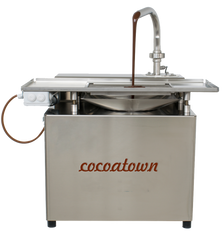CHOCOLATE MAKING PROCESS
Making Bean-to-Bar Chocolate the Authentic Way
In recent years the bean to bar chocolate making process has seen a rise in popularity as user-friendly equipment becomes more readily available. Advances in chocolate making equipment have taken us a long way from the Mayan method of grinding cocoa nibs by hand to make a chocolate drink. However, user friendly equipment is only one part of the bean to bar process.Learning to make and sell your own chocolate is an exciting prospect; but, in order to be successful, the process also involves investing the time to learn the chocolate making process. Learning the sources of cocoa beans and perfecting your own recipe are just as important as having the right equipment.
Below is a synopsis of the general chocolate making process: how chocolate makers roast, winnow, grind, and conch their cocoa beans today.
Deciding which variety and origin of cocoa beans will be used. There are four major varieties:
-
Forastero : The hardiest and most productive variety of cocoa, likely originated in Amazon basin. Grown around the world, Forastero beans account for over 90% percent of the world’s cacao. - Criollo: The rarest and most prized cocoa bean. Known for its delicate fragrance and complex flavor, this bean is native to regions consisting of current day Columbia and Venezuela, though it was found throughout Mesoamerica. Criollo beans account for less than 1% of the world’s cocoa.
- Trinitario: A hybrid of the flavorful Criollo and hardy Forastero beans, Trinitario beans are considered “flavor beans.” Threse beans t account for less than 5% of the world’s cacao.
- Nacional or Arriba: Cacao from Ecuador, considered a finer strain of Forastero.
Just like coffee beans, cocoa beans have characteristics specific to their geographical origin. The cocoa butter content and flavor profiles are unique to a certain region and variety of beans.
Cocoa farmers harvest and cut the pods to expose the cocoa beans and pulp. The beans and pulp are then placed in fermentation baskets, or wooden troughs, for several days. During the fermentation process, the pulp drains away and the beans develop a darker color and flavor.
The fermented beans are then dried in the sun. The drying process reduces the moisture content in the beans from about 60% to approximately 7.5%. Both the fermentation and drying processes happen in the fields where the cocoa trees are cultivated. A handful of chocolate makers are quite knowledgeable in the finesse these processes require, and help educate the farmers to ensure that these processes are completed correctly. Once the beans are dried, they are inspected and sold. So when you buy the beans, you can concentrate on the chocolate making process.
The next step is roasting, which brings out the most intense flavors and colors of the beans and kills any bacteria that may be present. To use a convection oven for roasting place the beans in a single layer and roast them according to the requirements of your recipe and beans. Make sure to stir the beans intermittently to ensure uniform heating. For small-scale operations, roasters help ensure consistent results with minimum intervention. Roasting time varies from 20-45 minutes depending on the bean variety, origin and cocoa butter content. Roasted beans must be cooled immediately to stop the roasting process (this prevents over-roasting or burning of the beans).
Now the roasted beans are cracked to expose the cocoa nibs (the essence of the cocoa bean and is full of cocoa solids and cocoa butter) inside the shell. Cracking the beans in a small quantity can be done in roller crackers, mini pre-grinders, or manually by hand peeling the shell.
Next, the winnowing process separates the nibs from the husk (broken shell pieces). Winnowing can be done using a fan, hair dryer or more sophisticated winnowers.
The clean nibs are then ground for up to 90 hours to make chocolate liquor. One can use a mini pre-grinder to powder the nibs (which reduces the grinding time in the melanger), screw type extruders to make a paste, or go straight to a melanger or grinder. Melangers and Grindeurs combine the age-old stone-on-stone grinding technique with the modern convenience of electricity. Grind the nibs to size of at least 90 microns and then add sugar.
Pre-grinding the sugar helps especially when using palm sugar, coconut sugar, or any crystallized sugar. One piece of advice is to avoid beet sugar, as it has completely different properties than cane sugar. Store bought powdered sugar is also not recommended as it contains additives which can alter the chocolate taste and texture. Adding the sugar at the right time is imperative to the texture and taste of the chocolate.
The conching process involves exposing the chocolate liquor to air to drive away volatiles and develop the right flavor for chocolate. The speed, temperature, and duration of the conching process determine the final texture and flavor.
The next step is tempering the chocolate. This can be done with a tempering machine or by hand on a marble slab. Heat the melted chocolate to 110-117 F°, then slowly cool it to 88-90 F° by stirring in finely-chopped cold chocolate pieces. The process of heating and cooling should be repeated a few times. The tempering process creates the snap and shine that is expected in the finished chocolate.
The final step in the process is molding. Custom molds and common tools such as ice cube trays can be used to create chocolates of the desired shape and size.
This is only an overview of the bean to bar process. Using the proper equipment will allow chocolate makers to customize the multiple steps in the chocolate making process, allowing them to stand out in a crowded market. We hope this overview has piqued your interest in chocolate making; and furthered your appreciation of bean-to-bar chocolates from sourcing to pricing.
To contact CocoaTown, please visit our website, www.cocoatown.com, or email us at info[at]cocoatown[dot]com

